March 27, 2007
Flesh on the Bone
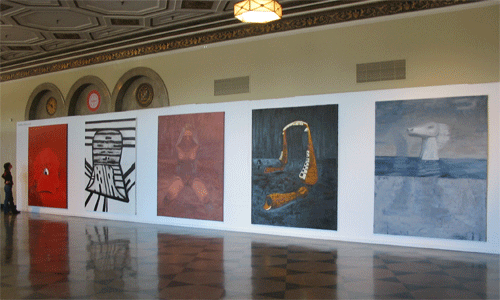
Earlier this month, I clipped a few paragraphs from an article printed in the Boston Globe and now many other places (Out of the Box) written by , a painter living in London and I jotted a quick note in the blogpost: "I found problems here and there amidst very sharp and insightful paragraphs. His concluding device announcing a "practical avant-garde" goes clunk for me but I'm keen to see more of Dushko Petrovich's work in the future." (You can find more of Dushko's writing at n+1 and paper monument.) It was one of those drive-by critiques, sketchy but in such cases I hope that a minimal level of craft balances the edge that looks for blood. It's hard to shake off the mentality inbred by the previous generation where one's missives are projected incognito, writers in paper media didn't get to connect so easily with the readership. Now, everyone is a reader and a writer, and this particular writer wrote back:
Dennis,Ah so. Now, I had to put some flesh on the bone. Dushko Petrovich and I corresponded a bit and he sent come images of his paintingsThank you for quoting me on your blog. Your short comments reflected my own feelings about the piece, and while I am grateful to you for emphasizing the good parts, you should also feel free to go into more detail about your doubts. It would probably save me the trouble!
If you want to read more of what I've written, or see paintings, let me know.
Best,
Dushko
"Dennis, I don't know how you want to display these, but I basically make little paintings (11"x14"") and then really big ones (7' x 8 1/2')and finally I asked if it was alright to post our exchange in the blog.
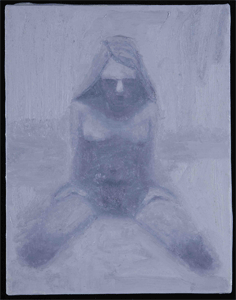
Here it is:
***
It was perhaps an erroneous? assumption that typing a message in the blind would allow me to be brusk (perhaps) with your piece, "Out of the box".? ?A note posted on the fly alerting friends to read an interesting article is not a review... however, any doubts that I may have imparted publicly about your work should have more flesh on it.? My apologies for that.??
Boiling it down, there are three aspects about your essay that I would like to focus on:
1.)? There is an implication that you have a perspective as a painter that might provide a lens that will illuminate the hurly burly of our dynamically changing artworld.? Initially, you connected painting to practicality.? Does this mean that painting has a grounding that other art forms do not have?? Will your essay only touch the painters among us?? Should it?
I just think that a painting is a pretty practical, efficient, time-tested means of expression. I'm also partial to oil paint, because of its versatility and durablity. (I think it was Neil Welliver who said : "It stays wet and it stays put.") If painting offers a special perspective, it is because it has hundreds of years of accmoplishment to test itself against, so it can (if it wants to) have some pretty powerful standards. Video art, whetever its merits, cannot claim this. Within what you call a dynamically changing art world, I would also point to painting's slowness as something that gives it a vantage point. I am still fleshing these things out, but I just wanted to give you a sense of my thinking here.2.)? Paragraphs 5/6 to 12ish comprise a summation of art history.? I agree that it is important to set out a normative interpretation of art history, the modern to postmodern era... especially the latter. ?This is a tough task indeed, and credit to you for taking it on.? Most people in our artworld would avoid the subject, claiming that any generalization would do violence to a core tenant of the postmodern era:? the damning exception that implicates the authoritarian impulse inherent in modernism.? Of course I reject this limitation and I am guessing that you do too, since you have taken on the task of standing back to look critically over the past fifty to one hundred years.? Bravo!?
Your device of the rectangle is brilliant, elegant.
But what I am saying is that your rendition was perhaps too succinct.? The story of contemporary art is tough enough for lay people... I am afraid that they might get lost even with the compass you provided them.? The story of the rectangle still had too much detail, a forest lost in the trees.? It is like a buck knife and a piece of flint:? one can indeed survive in the wild with these tools, but a slight elaboration might help the less adept among us.
And for us insiders, it was too scattershot, skipping on rocks across a big pond.? Everyone will have a favorite rock that must be touched upon for the passage to have a ring of truth to it.? Few will agree which trajectory is best.? The only artist's hearts you might touch are the ones whose soft spot is rectangular.
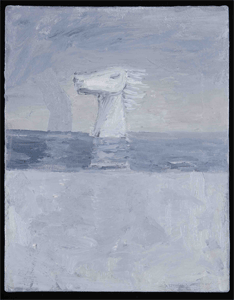
Well, I could say that the 1500 word newspaper article is a difficult form, and that the speech was initially given knowing that there would be a q&a afterwards, , but I should also mention that I like that kind of aphoristic description and would probably choose it even if someone offered me 3000 words or a longer speech. Part of that is personality, but part is profession. I'm not an art historian, and I'm not an academic, and I never make that kind of claim. My authority, if I have any, is just the fact that I have noticed something that might resonate with others.No doubt a lot of people have no idea what I'm talking about (I got a very sweet letter of admiration from a painter in Canada who was so glad to see me championing "triangles."), and no doubt a lot of professinals think I'm out of line, but those are just the risks of a middle path. I'm in it for the careful readers, and for the people who value a synthetic vision. In an era of neurotic specialization, I think some people need the reverse. So, yeah, I'm sure I lost people, and I didn't finish all my points, etc, but it's just one in a series of essays, and now I'm thinking about the next ones.
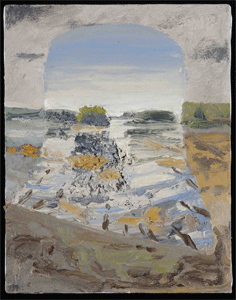
Of course, I truck out this part of my critique because I have a pet theory, my own schema... and I can only feel some trepidation in offering it to you.? I do not mean to arrogantly assert my own system, but only to offer it as an object example.? What is more important here is to emphasize the use of a comprehensible and hopefully decisive image of recent art history:? the modern into the postmodern.? I scribbled out a crude compass of my own in the blogpost "Be Mistrustful of History":
I will read this, I promise, but I can't fill my head with it right now because I am editing seven things at once for the magazine. In a week, I will have my head back.3.)? I identify strongly with your imperative to orient towards the affirmative and turn away from the strategies of negation that have been the legacy of the past 50 years of contemporary art.? I especially enjoy your call to bust the coagulation of "schools, publications, galleries, or even museums?" and invent other modalities of sharing the experience of art.??
Your indictment of careerism is supremely important, especially now when Paul Schimmel's "Public Offerings" prophesied that the imaginative-vision-invested art object has been eclipsed by the marketplace and artists have become branded manufacturers.? Cart leads horse.??
I admire the sandwich of grounded practicality and exotic leading edginess.
But like I wrote initially, I feel that "a practical avant-garde" doesn't have wings.? I think that the circle that we must square must somehow surmount the paradigm of the postmodern era and the modern era together.? Admittedly, this is a tough endeavor since the conceptualization must be on three levels:? the modern, the postmodern and the one that is suggested will supersede it.??Like the shift in dimensions from one to two to three to four, each must be an agile flip that incorporates the one below towards the one above.? Models centered on painting and avant-gardedness and practicality will be too easily rejected by those of us who work in the more ethereal or exotic arenas (performance, video, conceptual, whatever)... and perhaps rightfully so.
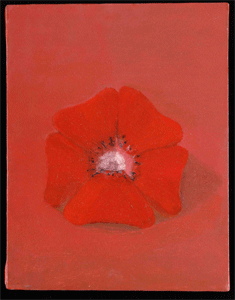
Well, you're definitely on to something here, and we'll proabaly get to watch it all play itself out, no?And this tracks back to issue number one above.? Painting alone might be too territorial for the job at hand.??The project of undertaking the critical analysis of a critical era (postmodernity) and suggesting a new paradigm for the coming era is too important to risk dismissal as reactionary "dumb as a painter" cliches (not yours, theirs).? We can't fight just for painting, but for all modalities of art making... even as -or despite the fact that- we ourselves believe painting to be the best and brightest of them all.? Furthermore, tomorrow's painting itself needs to be able to absorb and ingest the significance of the art forms that eclipsed it in the recent era.
I don't think painting is "one option among many" in artmaking, but I'll have to go into that another time. I also don't think it's the only way. It's more like the electric guitar is to rock and roll, no?
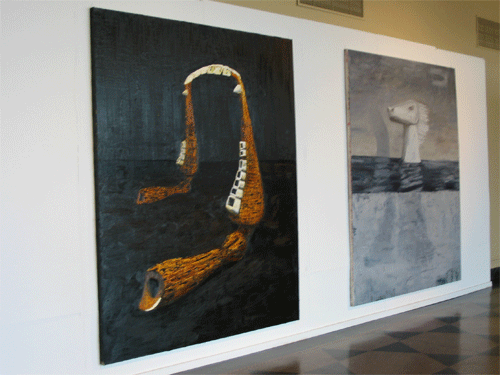 Posted by Dennis at March 27, 2007 11:42 AM
Posted by Dennis at March 27, 2007 11:42 AM
Leave a comment